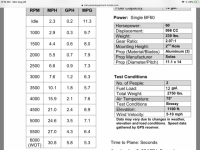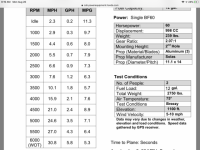Hunkydory
Active member
- Joined
- Mar 28, 2005
- Messages
- 2,745
- Reaction score
- 15
- C Dory Year
- 2000
- C Dory Model
- 22 Cruiser
- Hull Identification Number
- DOR22916I000
- Vessel Name
- Hunkydory
Fishcatcher,
I didn’t choose to set up the motors with the nmea 2000 information, so don’t have exact fuel burn rates, but with a internet search, I did come up with data using similar weight & prop pitch & diameter, that so far seems very close to my own very preliminary data using just fuel burned on the cruises so far at Lake Yellowstone & Powell. At Powell, I averaged 5.4 mpg with a 50/50 mix of displacement & on plane cruising with the boat fairly heavy. This is a chart I got off the internet & so far think the numbers close to what I’m seeing.

Jay
I didn’t choose to set up the motors with the nmea 2000 information, so don’t have exact fuel burn rates, but with a internet search, I did come up with data using similar weight & prop pitch & diameter, that so far seems very close to my own very preliminary data using just fuel burned on the cruises so far at Lake Yellowstone & Powell. At Powell, I averaged 5.4 mpg with a 50/50 mix of displacement & on plane cruising with the boat fairly heavy. This is a chart I got off the internet & so far think the numbers close to what I’m seeing.

Jay

